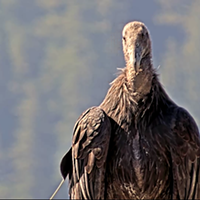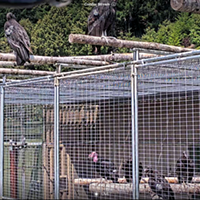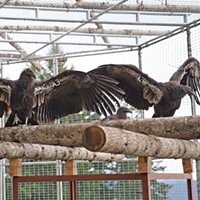News Blog

- Sequoia Park Zoo Facebook page
- A7 at the Oakland Zoo.
The California condor currently known as A7 is recovering after undergoing minor surgery by Oakland Zoo vets this week to remove what appeared to be an embedded bone fragment that caused an infection in her jaw.
The young female is part of a second cohort of the endangered birds that arrived on the North Coast in mid-August as part of a Yurok Tribe-led effort to return the endangered species they know as prey-go-neesh to the north reaches of its former territory.
According to the Oakland Zoo — where A7 arrived for treatment Oct. 12 — the fragment, which was “probably from something A7 had eaten, since condors eat lots of animal carcasses whole” — had lodged in A7’s cheek.
In the Facebook post, the zoo described it as being like what can happen with “a tortilla chip when you bite into it the wrong way.”
“We will bring A7 back to our Condor Recovery Center here at Oakland Zoo, and hopefully she’ll improve quickly and be transported back north to prepare for her upcoming release back into the wild!” the Oct. 19 post states.
Known as the Northern California Condor Restoration Program, the effort is a partnership between the Yurok Tribe and Redwood National and State Parks, which plans to reintroduce one cohort of prey-go-neesh every year for at least the next two decades.
The eventual goal for the local program is to act as a gateway for the species that continues to teeter on the brink of extinction to eventually spread its wings into the Pacific Northwest, where, as on the North Coast, the birds disappeared more than 100 years ago due to hunting, poisoning and habitat destruction.
A7 had been one of NCCRP’s first choices for an Oct. 11 release, with the team finding she appears to be vying for top spot in the new cohort’s hierarchical structure, along with A4, but the infection delayed her selection.
Instead A4 and A5 took their first forays into the wild that day, with A4 receiving the Yurok nickname Cher-perhl So-nee-ne-pek', which Yurok Wildlife Department Director Tiana Willams-Claussen said means "I feel strong," and A5 receiving the name "Neee'n," which means "Watcher," for his tendency to take a “watchful approach, observing the world around him.”
Those two joined four others — Ney-gem' 'Ne-chween-kah (She carries our prayers, A0), Hlow Hoo-let (Finally, I/we fly, A1), Nes-kwe-chokw' (He returns/arrives, A2) and Poy'-we-son (The one who goes ahead, “leader,” A3) — that took their historic flights in May and July, becoming the first of massive birds with a nearly 10-foot wingspan to do so locally in more than a century.
The hope is to release A7 and fourth condor, A6, soon. Over the last week or so, the NCCRP team has posted updates on A7, including details that the bird was acting “very strong and feisty, exactly what we look for in a healthy condor.” That, the team noted, clearly indicated “her medical issues are not hampering her too much, and as we hoped, treatment is now initiated prior to it affecting her overall health.”
The Oakland Zoo and the Sequoia Park Zoo are both NCCRP partners, with the latter helping with transportation of the birds — Sequoia Park Zoo Director Jim Campbell-Spickler took A7 to Oakland — and housing a temporary condor care facility onsite that was built in recent years.
Read more about the condor restoration program in the Journal's June 23 cover story here and on the Yurok Tribe website here. (Just a note, when the story went to print A0 had been on a long sojourn but she later returned to the management and release site.)




Comments